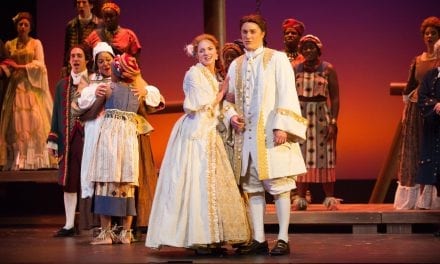SALT LAKE CITY — Lord of Misrule: Feast of Fools isn’t really so much a play, as much as it is an experience.
Lord of Misrule: Feast of Fools is an interactive production where the audience decides how the dialogue is performed or delivered. While admission is free, audience members can donate money either via cash or paid to the playwright’s Venmo account and select an absurd change from the Menu of Foolishness in the program. Throughout the play’s four act structure, seventeen different adjustments were selected to enhance the comedy of the play and boy were they amazing to behold.
Firstly, the play opens with the Lord of Misrule (RJ Walker, dressed as a court jester) explaining that he has created the The Judas Society, a fake cult-like group to ensnare a wealthy televangelist, Reverend J. Matthew Kim (played by Alton Phonepraseuth) and forcing him to create a play about Jesus. After the Lord of Misrule reveals his intentions to the audience, the other performers enter the single room that the play is being held in, all dressed in black, hooded velvet cloaks. The actors sit in a semi-circle on a few chairs, and the Lord of Misrule has instructed the audience to say, “Rise and Disrobe” after each person is introduced by the Reverend. In this way, the audience meets the other characters: Brixleigh Taylor (played by Autumn Nelson), Mark Bestor (played by Connor Bond), Steven Moore (played by Patrick Smith) and Sherrie Hightower (played by Comet Higley). All are all just as reprehensible as the Reverend in their own way.
One readily apparent drawback is that the acting was subpar; there are multiple times where Phonepraseuth fumbles over his lines, and Higley recites her lines while reading directly from the script. (It is important to note that Higley was an understudy replacing a performer who was exposed to COVID.) One difficulty may have been from the process of creating the show: the play was constructed backward where the actors created their own lines via improvisation, and Walker as playwright wrote them down. The result was a collaborative, but unrefined piece with no director. This instead a performance that a bunch of friends put together for their other friends. Nothing about the Lord of Misrule: Feast of Fools feels polished.
The absurdity of the play — which included having characters pretend to be in a film noir, actors doing celebrity impressions, the Reverend pretending to be an adorable cat boy — seems to be a difficult balance for the actors to strike. In Act III, the audience voted to have the characters pretend to be e-girls, saying “owo” at the end of their sentences, referring to each other with -sama (Japanese honorific) and speaking in an infantile tone. But in Act IV, when the audience voted for this scenario again, the actors weren’t as consistent and struggled to maintain the bit. In Act I, Sherrie had to repeat everything said to her in a condescending tone, but struggled to do this on top of her normal lines, even as the Page of Misrule (played by Alexa Blaise) would spray her for forgetting. Similarly, in Act II, the audience voted for the actors to do “funny walks only,” and almost no one did this consistently; the Lord of Misrule had to remind the actors about this choice but it did not stick.
One nice touch, though, was that during the act breaks, the actors helped change the stage and stayed in character the entire time. As I listened to their dialogue, they continued to talk to each other about why they were there as their characters. This helped to keep me focused on the play’s setting, instead of being disoriented with abrupt changes.
Will Greer’s lighting designs — especially the dramatic changes — had a level of professionalism that I appreciated. During the play about Jesus, the lights are a soft yellow, and switch to a softer white when the characters break out of the Jesus play and start arguing with each other. I also appreciated how the lights turned blue when the actors pretended to be in a film noir.
There are no moments of silence in Lord of Misrule. For example, when the Emperor of Rome (played by Nelson for the Jesus play) is trying to decide if she wants to put Jesus to death, the characters play a game show called “Pick Who Dies,” and there is music that plays as their selection process is happening. Music plays for a dance number toward the end, and during the film noir scene. Toward the end of the play, Greer plays the didgeridoo at random points throughout the last act (another selection from the Menu of Foolishness).
Finally, the costuming is efficient. Only the Page and Lord of Misrule are wearing unusual clothing (the Page has on black tights, black frilly shorts, and wears bunny ears that light up). The Reverend wears a suit when he first comes onto the stage, but everyone else is dressed in modern clothing, which is fitting since this is set today. The actors change their costumes when appropriate, and the play never loses sight of who their characters are supposed to be at any given time.
Although Lord of Misrule has a script, the ability for the audience to choose from the Menu of Foolishness immediately lends itself to a certain amount of improvisation that is fun and makes each night of the play a unique experience. Plus, the money donated during the performance goes to the University of Utah Prison Education Project, which sends school supplies to inmates. Once I saw Lord of Misrule: Feast of Fools as an experience or a Fringe production, it was easy to overlook the flaws and enjoy the evening.

These reviews are made possible by a grant from the Salt Lake County Zoo, Arts, and Parks program.




